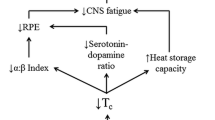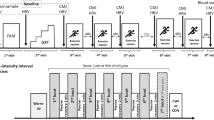Abstract
Purpose
To examine the effects of four commonly used recovery treatments applied between two bouts of intense endurance cycling on the performance of the second bout in normothermia (~21 °C).
Methods
Nine trained men completed two submaximal exhaustive cycling bouts (Ex1 and Ex2: 5 min at ~50 % \({\dot{\text{V}}\text{O}}_{2}\) peak, followed by 5 min at ~60 % \({\dot{\text{V}}\text{O}}_{2}\) peak and then ~80 % \({\dot{\text{V}}\text{O}}_{2}\) peak to failure) separated by 30 min of (a) cold water immersion at 15 °C (C15), (b) contrast water therapy alternating 2.5 min at 8 °C and 2.5 min at 40 °C (CT), (c) thermoneutral water immersion at 34 °C (T34) and (d) cycling at ~40 % \({\dot{\text{V}}\text{O}}_{2}\) peak (AR).
Results
Exercise performance, cardiovascular and metabolic responses during Ex1 were similar among all trials. However, time to failure (~80 % \({\dot{\text{V}}\text{O}}_{2}\) peak bout) during Ex2 was significantly (P < 0.05) longer in C15 (18.0 ± 1.6) than in CT (14.5 ± 1.5), T34 (12.4 ± 1.4) and AR (10.6 ± 1.0); and it was also longer (P < 0.05) in CT than AR. Core temperature and heart rate were significantly (P < 0.05) lower during the initial ~15 min of Ex2 during C15 compared with all other conditions but they reached similar levels at the end of Ex2.
Conclusions
A 30 min period of C15 was more beneficial in maintaining intense submaximal cycling performance than CT, T34 and AR; and CT was also more beneficial than T34 and AR. These effects were not mediated by the effect of water immersion per se, but by the continuous (C15) or intermittent (CT) temperature stimulus (cold) applied throughout the recovery.




Similar content being viewed by others
References
Arborelius M Jr, Ballidin UI, Lilja B, Lundgren CE (1972) Hemodynamic changes in man during immersion with the head above water. Aerosp Med 43:592–598
Bangsbo J, Graham T, Johansen L, Saltin B (1994) Muscle lactate metabolism in recovery from intense exhaustive exercise: impact of light exercise. J Appl Physiol 77:1890–1895
Bangsbo J, Aagaard T, Olsen M, Kiens B, Turcotte LP, Richter EA (1995) Lactate and H+ uptake in inactive muscles during intense exercise in man. J Physiol 488(Pt 1):219–229
Barnett A (2006) Using recovery modalities between training sessions in elite athletes: does it help? Sports Med 36:781–796
Bergh U, Ekblom B (1979) Influence of muscle temperature on maximal muscle strength and power output in human skeletal muscles. Acta Physiol Scand 107:33–37
Bigland-Ritchie B, Thomas CK, Rice CL, Howarth JV, Woods JJ (1992) Muscle temperature, contractile speed, and motoneuron firing rates during human voluntary contractions. J Appl Physiol 73:2457–2461
Bleakley CM, Davison GW (2010) What is the biochemical and physiological rationale for using cold-water immersion in sports recovery? A systematic review. Br J Sports Med 44:179–187
Booth J, Marino F, Ward JJ (1997) Improved running performance in hot humid conditions following whole body pre-cooling. Med Sci Sports Exer 29:943–949
Bristow GK, Sessler DI, Giesbrecht GG (1994) Leg temperature and heat content in humans during immersion hypothermia and rewarming. Avi Space Environ Med 65:220–226
Byrne C, Lim CL (2007) The ingestible telemetric body core temperature sensor: a review of validity and exercise applications. Br J Sports Med 41:126–133
Cohen J (1988) Statistical power analysis for behavioral sciences. Lawrence Erlbum Associates, Hillsdale
Crampton D, Donne B, Egaña M, Warmington SA (2011) Sprint cycling performance is maintained with short-term contrast water immersion. Med Sci Sports Exer 43:2180–2188
Crowe MJ, O’Connor D, Rudd D (2007) Cold water recovery reduces anaerobic performance. Int J Sports Med 28:994–998
Dunne A, Crampton D, Egaña M (2013) Effect of post-exercise hydrotherapy water temperature on subsequent exhaustive running performance in normothermic conditions. J Sci Med Sport 16:466–471
Gonzalez-Alonso J, Teller C, Andersen SL, Jensen FB, Hyldig T, Nielsen B (1999) Influence of body temperature on the development of fatigue during prolonged exercise in the heat. J Appl Physiol 86:1032–1039
Heyman E, DEG B, Mertens I, Meeusen R (2009) Effects of four recovery methods on repeated maximal rock climbing performance. Med Sci Sports Exer 41:1303–1310
Ingram J, Dawson B, Goodman C, Wallman K, Beilby J (2009) Effect of water immersion methods on post-exercise recovery from simulated team sport exercise. J Sci Med Sport 12:417–421
Jeukendrup A, Saris WH, Brouns F, Kester AD (1996) A new validated endurance performance test. Med Sci Sports Exer 28:266–270
Kay D, Taaffe DR, Marino FE (1999) Whole-body pre-cooling and heat storage during self-paced cycling performance in warm humid conditions. J Sports Sci 17:937–944
King M, Duffield R (2009) The effects of recovery interventions on consecutive days of intermittent sprint exercise. J Stren Con Res 23:1795–1802
Lee DT, Haymes EM (1995) Exercise duration and thermoregulatory responses after whole body pre-cooling. J Appl Physiol 79:1971–1976
Majerczak J, Korostynski M, Nieckarz Z, Szkutnik Z, Duda K, Zoladz JA (2012) Endurance training decreases the non-linearity in the oxygen uptake-power output relationship in humans. Exp Physiol 97:386–399
Marino FE (2002) Methods, advantages, and limitations of body cooling for exercise performance. Br J Sports Med 36:89–94
Marsh D, Sleivert G (1999) Effect of pre-cooling on high intensity cycling performance. Br J Sports Med 33:393–397
McAinch AJ, Febbraio MA, Parkin JM, Zhao S, Tangalakis K, Stojanovska L, Carey MF (2004) Effect of active versus passive recovery on metabolism and performance during subsequent exercise. Int J Sport Nutr Exer Metab 14:185–196
Mittleman KD, Mekjavic IB (1988) Effect of occluded venous return on core temperature during cold water immersion. J Appl Physiol 65:2709–2713
Morrison AB, Schoffl VR (2007) Physiological responses to rock climbing in young climbers. Br J Sports Med 41:852–861
Parkin JM, Carey MF, Zhao S, Febbraio MA (1999) Effect of ambient temperature on human skeletal muscle metabolism during fatiguing submaximal exercise. J Appl Physiol 86:902–908
Peiffer JJ, Abbiss CR, Watson G, Nosaka K, Laursen PB (2010a) Effect of a 5-min cold-water immersion recovery on exercise performance in the heat. Br J Sports Med 44:461–465
Peiffer JJ, Abbiss CR, Watson G, Nosaka K, Laursen PB (2010b) Effect of cold water immersion on repeated 1-km cycling performance in the heat. J Sci Med Sport 13:112–116
Pournot H, Bieuzen F, Duffield R, Lepretre PM, Cozzolino C, Hausswirth C (2011) Short term effects of various water immersions on recovery from exhaustive intermittent exercise. Eur J Appl Physiol 111:1287–1295
Rowsell GJ, Coutts AJ, Reaburn P, Hill-Haas S (2009) Effects of cold-water immersion on physical performance between successive matches in high-performance junior male soccer players. J Sports Sci 27:565–573
Schniepp J, Campbell TS, Powell KL, Pincivero DM (2002) The effects of cold-water immersion on power output and heart rate in elite cyclists. J Stren Con Res 16:561–566
Stanley J, Buchheit M, Peake JM (2012) The effect of post-exercise hydrotherapy on subsequent exercise performance and heart rate variability. Eur J Appl Physiol 112:951–961
Vaile J, Halson S, Gill N, Dawson B (2008a) Effect of cold water immersion on repeat cycling performance and thermoregulation in the heat. J Sports Sci 26:431–440
Vaile J, Halson S, Gill N, Dawson B (2008b) Effect of hydrotherapy on recovery from fatigue. Int J Sports Med 29:539–544
Vaile J, O’Hagan C, Stefanovic B, Walker M, Gill N, Askew CD (2011) Effect of cold water immersion on repeated cycling performance and limb blood flow. Br J Sports Med 45:825–829
Versey N, Halson S, Dawson B (2011) Effect of contrast water therapy duration on recovery of cycling performance: a dose-response study. Eur J Appl Physiol 111:37–46
Watts PB (2004) Physiology of difficult rock climbing. Eur J Appl Physiol 91:361–372
Weerapong P, Hume PA, Kolt GS (2004) Stretching: mechanisms and benefits for sport performance and injury prevention. Phys Ther Rev 9:189–206
Wilcock IM, Cronin JB, Hing WA (2006) Physiological response to water immersion: a method for sport recovery? Sports Med 36:747–765
Yeargin SW, Casa DJ, McClung JM, Knight JC, Healey JC, Goss PJ, Harvard WR, Hipp GR (2006) Body cooling between two bouts of exercise in the heat enhances subsequent performance. J Stren Con Res 20:383–389
Zoladz JA, Rademaker AC, Sargeant AJ (1995) Non-linear relationship between O2 uptake and power output at high intensities of exercise in humans. J Physiol 488(Pt 1):211–217
Zoladz JA, Duda K, Majerczak J (1998) Oxygen uptake does not increase linearly at high power outputs during incremental exercise test in humans. Eur J Appl Physiol Occ Physiol 77:445–451
Conflict of interest
The authors declare they have no conflict of interest.
Author information
Authors and Affiliations
Corresponding author
Additional information
Communicated by Guido Ferretti.
Rights and permissions
About this article
Cite this article
Crampton, D., Donne, B., Warmington, S.A. et al. Cycling time to failure is better maintained by cold than contrast or thermoneutral lower-body water immersion in normothermia. Eur J Appl Physiol 113, 3059–3067 (2013). https://doi.org/10.1007/s00421-013-2737-1
Received:
Accepted:
Published:
Issue Date:
DOI: https://doi.org/10.1007/s00421-013-2737-1




